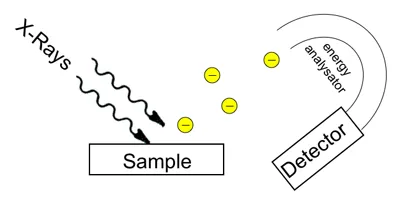
X-Ray Photoemission spectroscopy (XPS) uses X-ray radiation to probe the binding energy of electrons of the material under study. The incoming light with a fixed photon energy excites electrons from their bound states into free electrons with a kinetic energy that is smaller for formerly stronger bound electrons. With an energy analyzer electrons of specific kinetic energy can be selected and counted by the detector. Thus the signal is the number of counted electrons over kinetic energy.

When we focus on the kinetic energy connected with electrons from a certain state of an element the chemical environment of the element is reflected in small shift of the binding energy of that state. For example carbon atoms have 1s electron with a binding energy of typically 285 eV. If the carbon atoms are connected to other atoms like in phenyl (Ph), carbon monoxide (CO), carboxylate (COO-) or carboxyl (COOH) groups, each group exhibits a characteristic binding energy. By analyzing peak positions and intensities under different experimental situations one one determines the states of the sample.